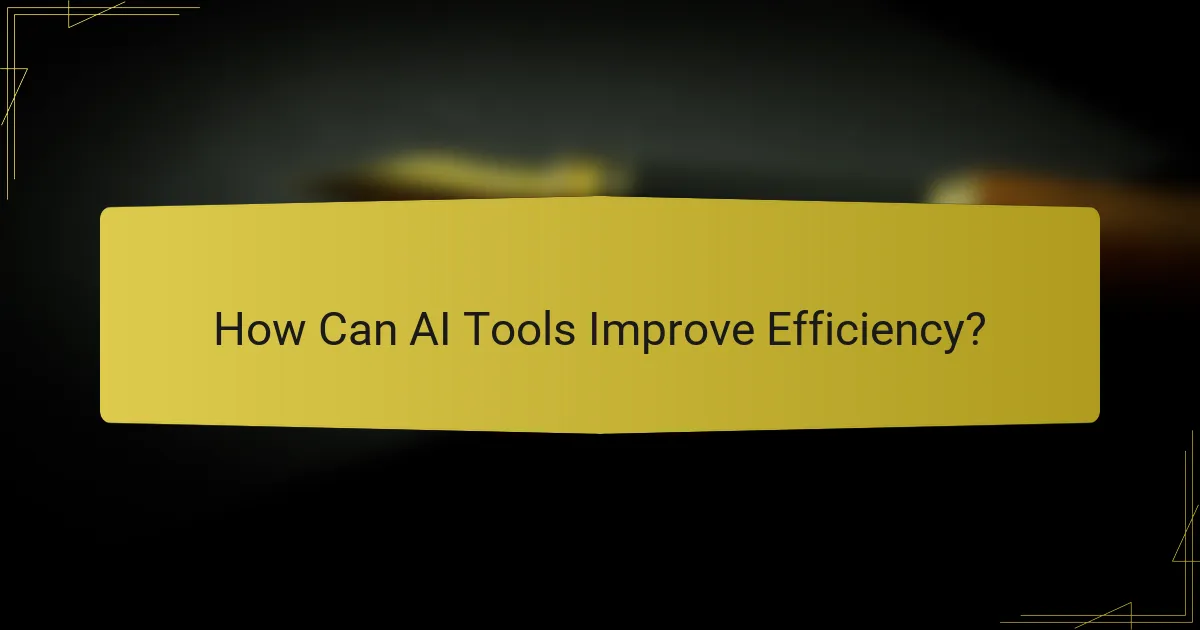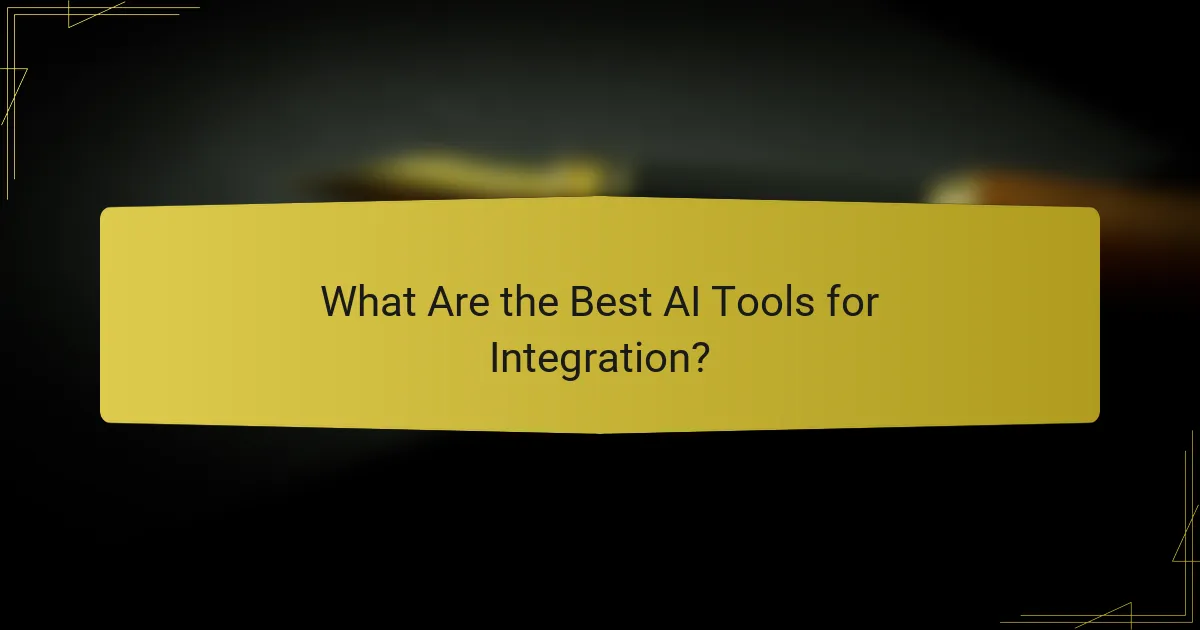AI tools are revolutionizing the way businesses operate by significantly enhancing efficiency, integration, and scalability. By automating repetitive tasks and optimizing resource allocation, these tools not only save time but also boost productivity. Furthermore, they facilitate seamless integration of various applications, allowing organizations to streamline workflows and manage increased workloads without escalating costs or complexity.

How Can AI Tools Improve Efficiency?
AI tools enhance efficiency by automating repetitive tasks, analyzing data faster, prioritizing tasks effectively, and optimizing resource allocation. These improvements lead to significant time savings and increased productivity across various sectors.
Automated workflows
Automated workflows streamline processes by reducing manual intervention, which minimizes errors and speeds up task completion. For example, AI can manage email responses or schedule meetings, allowing employees to focus on more strategic activities.
Implementing automation tools requires careful planning. Identify repetitive tasks that can be automated and choose the right AI solutions that integrate well with existing systems. Regularly review these workflows to ensure they remain effective and relevant.
Data analysis acceleration
AI tools can process and analyze large datasets much faster than traditional methods, providing insights in real-time. This acceleration enables businesses to make informed decisions quickly, adapting to market changes or customer needs more effectively.
To leverage this capability, organizations should invest in AI analytics platforms that can handle their specific data types. Ensure that the data is clean and well-structured to maximize the effectiveness of AI-driven analysis.
Task prioritization
AI can assist in task prioritization by analyzing deadlines, project importance, and resource availability. This helps teams focus on high-impact tasks, improving overall productivity and project outcomes.
Utilize AI-driven project management tools that offer prioritization features. Regularly update task parameters and review priorities to adapt to shifting project dynamics, ensuring that the most critical tasks are always addressed first.
Resource optimization
AI tools optimize resource allocation by analyzing usage patterns and predicting future needs. This leads to better utilization of human and material resources, reducing waste and costs.
To achieve effective resource optimization, implement AI solutions that provide insights into resource consumption. Monitor performance metrics and adjust allocations based on predictive analytics to maintain efficiency and cost-effectiveness.

What Are the Best AI Tools for Integration?
The best AI tools for integration streamline processes by connecting various applications and automating workflows. These tools enhance efficiency and scalability, allowing businesses to optimize operations without extensive manual intervention.
Zapier for automation
Zapier is a popular tool that automates tasks between different web applications. It allows users to create “Zaps,” which are workflows that connect apps like Gmail, Slack, and Trello, enabling seamless data transfer and task automation.
To get started, users can choose from thousands of app integrations and set triggers and actions. For example, a Zap can automatically save email attachments from Gmail to Dropbox, saving time and reducing manual effort.
Common pitfalls include overcomplicating Zaps with too many steps, which can lead to errors. It’s best to keep workflows simple and test them thoroughly before relying on them for critical tasks.
Microsoft Power Automate
Microsoft Power Automate, formerly known as Microsoft Flow, is designed for users within the Microsoft ecosystem. It integrates seamlessly with Microsoft 365 applications and other services, allowing users to automate repetitive tasks and processes.
Power Automate offers a user-friendly interface to create flows that can trigger actions based on events, such as receiving an email or updating a file in SharePoint. For instance, a flow can notify a team via Teams whenever a new file is added to a specific folder.
When using Power Automate, ensure that you understand the licensing model, as some features may require premium subscriptions. It’s also advisable to monitor flow performance to avoid bottlenecks in operations.
Integromat for workflows
Integromat, now rebranded as Make, is a powerful tool for creating complex workflows between various applications. It allows users to visually design integrations and automate processes with a drag-and-drop interface.
With Integromat, users can connect multiple apps and services, setting up scenarios that execute based on specific conditions. For example, you can create a scenario that updates a Google Sheet whenever a new lead is added in your CRM.
One key advantage of Integromat is its ability to handle intricate workflows with conditional logic and data manipulation. However, users should be cautious of the learning curve associated with its more advanced features and plan scenarios carefully to avoid unexpected outcomes.

How Do AI Tools Enhance Scalability?
AI tools enhance scalability by automating processes, optimizing resource allocation, and enabling businesses to manage increased workloads efficiently. This allows organizations to grow without a proportional increase in operational costs or complexity.
Cloud-based solutions
Cloud-based solutions provide flexible resources that can be scaled up or down based on demand. This elasticity allows businesses to handle varying workloads without investing heavily in physical infrastructure. For example, a company can quickly increase its computing power during peak times and reduce it during off-peak periods, optimizing costs.
Additionally, cloud platforms often offer pay-as-you-go pricing models, which can significantly reduce upfront investments. Organizations can thus allocate budget more effectively, focusing on growth rather than maintenance of hardware.
Load balancing features
Load balancing features distribute workloads across multiple servers or resources, ensuring no single component is overwhelmed. This not only enhances performance but also improves reliability, as it reduces the risk of downtime. For instance, during high traffic periods, a load balancer can redirect requests to less busy servers, maintaining a smooth user experience.
Implementing effective load balancing can lead to better resource utilization and can support a larger number of concurrent users. It’s essential to choose a load balancing solution that fits the specific needs of your application, whether it’s round-robin, least connections, or IP hash methods.
Real-time data processing
Real-time data processing allows organizations to analyze and act on data as it is generated, which is crucial for scalability. This capability enables businesses to respond quickly to changing conditions, such as customer behavior or market trends. For example, e-commerce platforms can adjust inventory levels dynamically based on real-time sales data.
To implement real-time data processing, consider using technologies like Apache Kafka or AWS Kinesis, which can handle large streams of data efficiently. However, ensure that your infrastructure can support the increased data flow to avoid bottlenecks that could hinder scalability.

What Criteria Should You Consider When Choosing AI Tools?
When selecting AI tools, consider compatibility with existing systems, cost-effectiveness, and user-friendliness. These criteria ensure that the tools integrate smoothly into your operations, provide value for money, and are easy for your team to adopt.
Compatibility with existing systems
Assessing compatibility with your current systems is crucial for seamless integration. Look for AI tools that can easily connect with your existing software, databases, and workflows. This minimizes disruption and reduces the need for extensive retraining or system overhauls.
Check for APIs, plugins, or built-in integrations that facilitate communication between systems. Tools that support common standards or protocols will typically offer better compatibility, saving time and resources during implementation.
Cost-effectiveness
Cost-effectiveness involves evaluating not just the initial purchase price but also ongoing expenses such as maintenance, training, and potential upgrades. Aim for tools that provide a clear return on investment, whether through increased efficiency, reduced labor costs, or enhanced capabilities.
Consider subscription models versus one-time purchases. Subscription-based tools may offer lower upfront costs but can accumulate higher expenses over time. Analyze your budget and project needs to determine the most financially viable option.
User-friendliness
User-friendliness is essential for ensuring that your team can quickly adapt to new AI tools. Look for intuitive interfaces, comprehensive support resources, and training options. Tools that require minimal technical expertise will facilitate smoother adoption and reduce the learning curve.
Gather feedback from potential users during the evaluation process. Conduct trials or demos to assess how easily team members can navigate the tool and complete tasks. A user-friendly AI tool can significantly enhance productivity and satisfaction among your staff.

What Are the Key Benefits of AI Tool Integration?
AI tool integration offers significant advantages, including increased efficiency, enhanced collaboration, and improved data accuracy. By seamlessly connecting various AI solutions, organizations can streamline workflows and make more informed decisions.
Streamlined operations
Integrating AI tools can significantly streamline operations by automating repetitive tasks and optimizing workflows. For instance, using AI-driven software for data entry can reduce processing time from hours to mere minutes, freeing up employees for higher-value work.
Consider implementing AI solutions that connect with existing systems to minimize disruption. This ensures a smoother transition and maximizes the benefits of automation while maintaining operational continuity.
Improved collaboration
AI tool integration fosters improved collaboration among teams by providing shared access to data and insights. Tools that utilize AI can analyze team performance and suggest optimal collaboration strategies, enhancing overall productivity.
For example, integrating AI-driven project management tools can help teams prioritize tasks based on real-time data, ensuring that everyone is aligned on goals and deadlines. This alignment can lead to faster project completion and better outcomes.
Enhanced data accuracy
Integrating AI tools enhances data accuracy by leveraging machine learning algorithms to identify and correct errors in real time. This capability reduces the risk of human error and ensures that decision-makers have access to reliable information.
Organizations should prioritize AI solutions that offer data validation features, which can automatically flag inconsistencies or anomalies. By maintaining high data quality, businesses can make better strategic decisions and improve overall performance.

What Are the Challenges of Implementing AI Tools?
Implementing AI tools presents several challenges, including data privacy concerns, integration complexities, and scalability issues. Organizations must navigate these hurdles to effectively leverage AI technologies while ensuring compliance and operational efficiency.
Data privacy concerns
Data privacy is a significant challenge when implementing AI tools, as these systems often require access to sensitive personal information. Organizations must ensure that they comply with regulations such as the General Data Protection Regulation (GDPR) in Europe or the California Consumer Privacy Act (CCPA) in the United States.
To address data privacy concerns, companies should adopt robust data governance frameworks. This includes conducting regular audits, implementing data encryption, and ensuring that data collection practices are transparent to users. For example, businesses can anonymize data to minimize risks while still gaining valuable insights.
Additionally, organizations should educate employees about data privacy best practices and establish clear protocols for handling personal information. This proactive approach can help mitigate risks and build trust with customers, ultimately supporting the successful implementation of AI tools.
